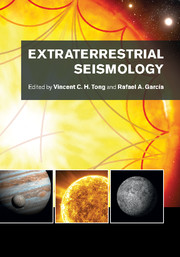Book contents
- Frontmatter
- Contents
- List of contributors
- Preface
- Acknowledgements
- List of abbreviations
- Planetary seismology: High risk, high return
- A bright outlook for helio- and asteroseismology
- Part I Observation and space missions
- Part II Data and physical parameters
- Part III Modeling approaches
- Part IV Discoveries of physical structures and processes
- Part V Interdisciplinary research involving planetary and astrophysical sciences
- 16 Diskoseismology of accretion disks
- 17 Numerical simulations of magnetoconvection and helioseismology
- 18 Impact seismology on terrestrial and giant planets
- 19 Angular momentum transport in stars: From short to long time scales
- 20 From the Sun to the distant stars, and back: Future research directions
- 21 Stellar dynamics: Rotation, convection, and magnetic fields
- 22 Sunquakes: Helioseismic response to solar flares
- 23 Seismic waves in small bodies: Sources and propagation
- Part VI Interdisciplinary research involving terrestrial seismology
- References
- Index
17 - Numerical simulations of magnetoconvection and helioseismology
from Part V - Interdisciplinary research involving planetary and astrophysical sciences
Published online by Cambridge University Press: 05 July 2015
- Frontmatter
- Contents
- List of contributors
- Preface
- Acknowledgements
- List of abbreviations
- Planetary seismology: High risk, high return
- A bright outlook for helio- and asteroseismology
- Part I Observation and space missions
- Part II Data and physical parameters
- Part III Modeling approaches
- Part IV Discoveries of physical structures and processes
- Part V Interdisciplinary research involving planetary and astrophysical sciences
- 16 Diskoseismology of accretion disks
- 17 Numerical simulations of magnetoconvection and helioseismology
- 18 Impact seismology on terrestrial and giant planets
- 19 Angular momentum transport in stars: From short to long time scales
- 20 From the Sun to the distant stars, and back: Future research directions
- 21 Stellar dynamics: Rotation, convection, and magnetic fields
- 22 Sunquakes: Helioseismic response to solar flares
- 23 Seismic waves in small bodies: Sources and propagation
- Part VI Interdisciplinary research involving terrestrial seismology
- References
- Index
Summary
The complex dynamics of highly turbulent solar magneto convection is a source of acoustic waves, and also various self-organization processes, observed on different scales on the Sun: from tiny vortex tubes to large-scale convection and active regions. Recent advances in computational capabilities have made it possible to create realistic numerical models, based on first principles, including radiative energy transfer, ionization, and magnetic fields. The simulations have provided important insight into the mechanism of acoustic emission on the Sun, and the physics of wave interactions with flows and magnetic fields. Observations of subsurface dynamics of the Sun by helioseismology are obtained by measuring acoustic travel-time anomalies, and reconstructing variations of the sound speed and behavior of convective flows in the solar interior. However, strong stratification of the turbulent convective medium, in homogeneity of flow, and complicated topology of the magnetic field create uncertainty in interpretation of helioseismology observations. Because there are no direct subsurface observations, a synergy of the magneto hydrodynamic (MHD) numerical simulations and observations provides a basis for verification and improvement of helioseismology methods.
Introduction
Understanding and characterization of solar magneto convection is a key problem of heliophysics and astrophysics. Solar turbulence driven by convective energy transport determines the dynamical state of the plasma, and leads to excitation of acoustic waves. Observed oscillations contain information about hidden dynamics of the subsurface layers, and are a powerful tool to probe the solar and stellar interior conditions.
Large parallel supercomputers, especially those developed in the last few years, allow us to perform large-scale realistic simulations of MHD processes on the Sun. These simulations have greatly improved our understanding of the multi-scale structure and dynamics of solar convection. A characteristic feature of simulations of this type is that they include all essential physics from first principles, and take into account the real-plasma equation of state, radiative transfer, chemical composition, ionization effects, and the effects of magnetic fields, but they do rely on subgrid-scale models of turbulence.
- Type
- Chapter
- Information
- Extraterrestrial Seismology , pp. 238 - 249Publisher: Cambridge University PressPrint publication year: 2015



